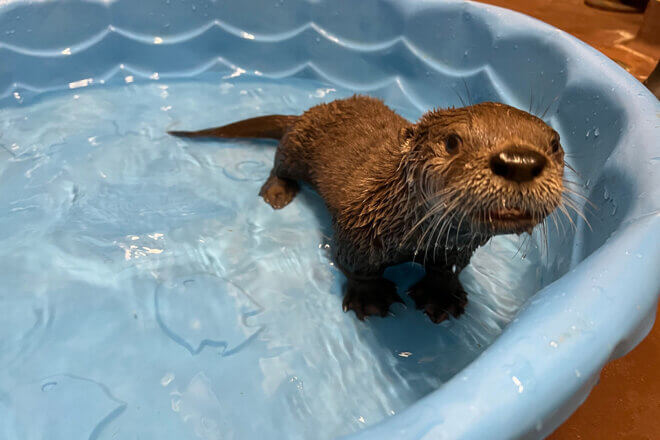BALTIMORE, MD – The Maryland Zoo, the Pennsylvania Game Commission, and the University of Pennsylvania School of Veterinary Medicine’s Wildlife Futures Program are members of the Allegheny Woodrat Working Group that have teamed up to start a Woodrat Captive Breeding Program (WCBP) to rebuild struggling populations of Allegheny woodrats (Neotoma magister).
Through the program, a small number of wild animals will form a founding colony at Maryland Zoo. The first such woodrat, a female from Mifflin County, PA turned out to be pregnant and subsequently gave birth to three pups at the Zoo. Ultimately, she will be joined by woodrats from Virginia and Indiana to breed future generations.
The current pups will stay at Maryland Zoo for a few weeks before being transferred to a soft release pen where they’ll grow and become acclimated to the wild before being released on their own. Because the pups will be released into the wild, the WCBP team is taking a hands off approach so the animals don’t form human attachments that would limit their chances for success after release. Keepers are primarily monitoring the pups via a nest box camera.
“We previously had Allegheny woodrats and were quite successful at breeding them so I’m optimistic about having lots of pups to release into the wild,” said Erin Cantwell Grimm, Mammal Curator at the Maryland Zoo.
Work is also ongoing to improve habitat at woodrat sites throughout their range in the Appalachian mountains. At one time, the Allegheny woodrat’s range extended from southwestern Connecticut west to Indiana and south to northern Alabama. These animals are now listed as Endangered in Indiana, Ohio, Maryland, New Jersey, and New York and are considered a species of conservation concern in Pennsylvania, Virginia,Tennessee, Kentucky, North Carolina, and West Virginia. As a result, these states and their university and zoo partners have come together to form the Allegheny Woodrat Working Group to coordinate a range-wide recovery effort and prevent federal listing of the species.
Fragmentation of forest habitat, the loss of food sources due to invasive species, a highly fatal parasite spread by raccoons, and increased populations of native food competitors like deer, bear, and squirrels are among the factors that have caused range-wide declines of woodrat populations, including a 70% decline in Pennsylvania over the past forty years.
“Woodrat populations have declined so much that they have become isolated from one another. That leads to low genetic diversity and eventually to inbreeding, which is yet another factor in population decline,” said Kate Amspacher Otterbein, Mammal Recovery Specialist at the Pennsylvania Game Commission.
The goal of the WCBP is to produce genetically diverse woodrats that can be reintroduced back to the wild to improve genetic diversity of remaining woodrat populations. This is just one piece of the multi-faceted recovery approach that the Allegheny Woodrat Working Group is developing.
ABOUT ALLEGHENY WOODRATS
Allegheny woodrats are a species of woodrat, often called packrats, that live only in the Appalachian mountains. As noted by the Pennsylvania Game Commission, they are habitat specialists that require rocky outcrops and talus slopes embedded within healthy forests with plentiful food.
Allegheny woodrats do not hibernate; instead, they build a cache of food to survive the winter. They also often collect non-food items such as bottle caps, snake skins, and shotgun shells, lending to the packrat moniker.
Although this animal is referred to as a “rat” it is more mouse-like in appearance and has a bicolor, furred tail – unlike the naked tail of the non-native Norway rat. It also is distinguished by noticeably larger ears and eyes, a larger, heavier head, and much longer whiskers. It is gray above with white underparts and paws. The average adult weighs less than a pound and is about 17 inches in total length, including an eight-inch tail.






Share this article